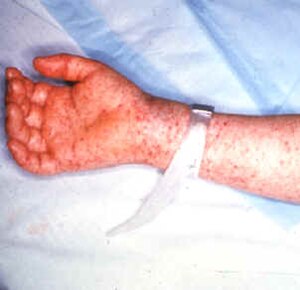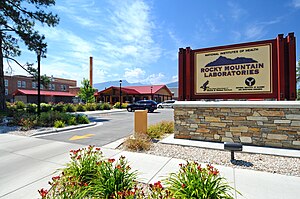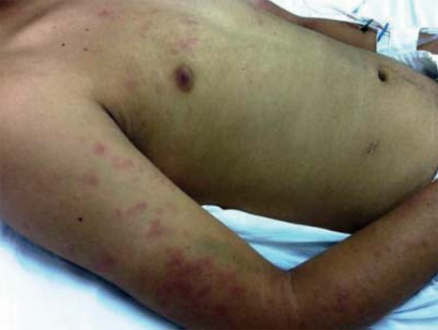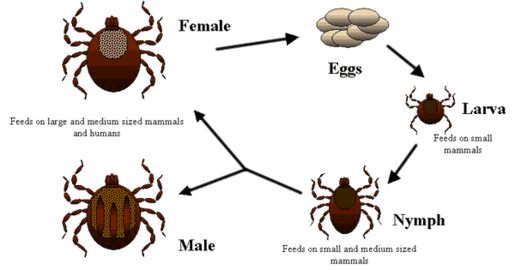Rocky Mountain spotted fever
| Rocky Mountain spotted fever | |
|---|---|
| Other names: Blue disease,[1] Brazilian spotted fever, Tobia fever, new world spotted fever, tick- borne typhus fever, Sao Paulo fever[2] | |
 | |
| Petechial rash on the arm caused by Rocky Mountain spotted fever | |
| Specialty | Infectious disease |
| Symptoms | Early: Fever, headache[3] Later: Rash[3] |
| Complications | Hearing loss, loss of limbs[3] |
| Usual onset | 2 to 14 days after infection[2] |
| Duration | 2 weeks[2] |
| Causes | Rickettsia rickettsii spread ticks[4] |
| Diagnostic method | Based on symptoms[5] |
| Differential diagnosis | Zika fever, dengue, chikungunya, Rickettsia parkeri rickettsiosis, Pacific Coast tick fever, rickettsialpox[6][7] |
| Treatment | Doxycycline[8] |
| Prognosis | 0.5% risk of death[6] |
| Frequency | < 5,000 cases per year (USA)[6] |
Rocky Mountain spotted fever (RMSF) is a bacterial disease spread by ticks.[9] It typically begins with a fever and headache, which is followed a few days later with the development of a rash.[3] The rash is generally made up of small spots of bleeding and starts on the wrists and ankles.[10] Other symptoms may include muscle pains and vomiting.[3] Long-term complications following recovery may include hearing loss or loss of part of an arm or leg.[3]
The disease is caused by Rickettsia rickettsii, a type of bacterium that is primarily spread to humans by American dog ticks, Rocky Mountain wood ticks, and brown dog ticks.[4] Rarely the disease is spread by blood transfusions.[4] Diagnosis in the early stages is difficult.[5] A number of laboratory tests can confirm the diagnosis but treatment should be begun based on symptoms.[5] It is within a group known as spotted fever rickettsiosis, together with Rickettsia parkeri rickettsiosis, Pacific Coast tick fever, and rickettsialpox.[6]
Treatment of RMSF is with the antibiotic doxycycline.[8] It works best when started early and is recommended in all age groups, as well as during pregnancy.[8] Antibiotics are not recommended for prevention.[8] Approximately 0.5% of people who are infected die as a result.[6] Before the discovery of tetracycline in the 1940s, more than 10% of those with RMSF died.[6]
Fewer than 5,000 cases are reported a year in the United States, most often in June and July.[6] It has been diagnosed throughout the contiguous United States, Western Canada, and parts of Central and South America.[10][2] Rocky Mountain spotted fever was first identified in the 1800s in the Rocky Mountains.[10]
Signs and symptoms

People infected usually notice symptoms following a period of one to two weeks after a tick bite. The early symptoms are nonspecific and may resemble a variety of other infectious and noninfectious diseases.[3][11][12]
The symptoms are as follows:[12][3][11][13][14]
- Fever
- Nausea
- Vomiting
- Severe headache
- Muscle pain
- Lack of appetite
- Maculopapular rash
- Petechial rash
- Abdominal pain
- Joint pain
- Conjunctivitis
- Forgetfulness
The classic three findings are fever, rash, and history of tick bite. However, this combination is often not identified when people initially present for care. The rash has an "inward" pattern of spread, meaning it begins at the extremities and courses towards the trunk.[15][16]
Rash
The rash first appears two to five days after the onset of fever, and it is often quite subtle. Younger patients usually develop the rash earlier than older patients. Most often the rash begins as small, flat, pink, nonitchy spots (macules) on the wrists, forearms, and ankles. These spots turn pale when pressure is applied and eventually become raised on the skin. The characteristic red, spotted (petechial) rash of Rocky Mountain spotted fever is usually not seen until the sixth day or later after onset of symptoms, but this type of rash occurs in only 35 to 60% of patients with Rocky Mountain spotted fever. The rash involves the palms or soles in as many as 80% of people. However, this distribution may not occur until later on in the course of the disease. As many as 15% of patients may never develop a rash.[17]
-
Right hand and wrist displaying the characteristic spotted rash of Rocky Mountain spotted fever
-
Maculopapular exanthema and purpura in arms
Complications
People can develop permanent disabilities including "cognitive deficits, ataxia, hemiparesis, blindness, deafness, or amputation following gangrene".[7]
Cause

Ticks are the natural hosts of the disease, serving as both reservoirs and vectors of R. rickettsii Ticks transmit the bacteria primarily by their bites, less commonly, infections may occur following exposure to crushed tick tissues, or tick feces.[18][13][19]
A female tick can transmit R. rickettsii to her eggs in a process called transovarial transmission. Ticks can also become infected with R. rickettsii while feeding on blood from the host in either the larval or nymphal stage. After the tick develops into the next stage, the R. rickettsii may be transmitted to the second host during the feeding process, furthermore, male ticks may transfer R. rickettsii to female ticks through body fluids or spermatozoa during the mating process. These types of transmission represent how generations or life stages of infected ticks are maintained.[20][13][19]
Rickettsiae are transmitted to through saliva injected while a tick is feeding. Unlike Lyme disease and other tick-borne pathogens that require a prolonged attachment period to establish infection, a person can become infected with R. rickettsii in a feeding time as short as 2 hours.[21] In general, about 1-3% of the tick population carries R. rickettsii, even in areas where the majority of human cases are reported. Therefore, the risk of exposure to a tick carrying R. rickettsii is low.[19][22]
The disease is spread by the American dog tick (Dermacentor variabilis), Rocky Mountain wood tick (D. andersoni), brown dog tick (Rhipicephalus sanguineus), and Amblyomma sculptum.[23][24]
The two major vectors of R. rickettsii in the United States are the American dog tick and the Rocky Mountain wood tick. American dog ticks are widely distributed east of the Rocky Mountains and they also occur in limited areas along the Pacific Coast. Dogs and medium-sized mammals are the preferred hosts of an adult American dog tick, although it feeds readily on other large mammals, including human beings. This tick is the most commonly identified species responsible for transmitting R. rickettsii to humans. Rocky Mountain wood ticks are found in the Rocky Mountain states and in southwestern Canada. The lifecycle of this tick may require up to three years for its completion. The adult ticks feed primarily on large mammals.[25][19][26]
-
The lifecycle of Dermacentor variabilis and Dermacentor andersoni ticks (Family Ixodidae)
-
American dog tick (Dermacentor variabilis) range
-
Rocky Mountain wood tick (Dermacentor andersoni) range
Pathophysiology
Entry into host
Rickettsia rickettsii can be transmitted to human hosts through the bite of an infected tick. As with other bacterium transmitted via ticks, the process generally requires a period of attachment of 4 to 6 hours. However, in some cases a Rickettsia rickettsii infection has been contracted by contact with tick tissues or fluids. Then, the bacteria induce their internalization into host cells via a receptor-mediated invasion mechanism.[27][28]
Researchers believe that this mechanism is similar to that of Rickettsia conorii. This species of Rickettsia uses an abundant cell surface protein called OmpB to attach to a host cell membrane protein called Ku70. It has previously been reported that Ku70 migrates to the host cell surface in the presence of "Rickettsia".[29] Then, Ku70 is ubiquitinated by c-Cbl, an E3 ubiquitin ligase. This triggers a cascade of signal transduction events resulting in the recruitment of Arp2/3 complex. CDC42, protein tyrosine kinase, phosphoinositide 3-kinase, and Src-family kinases then activate Arp2/3. This causes the alteration of local host cytoskeletal actin at the entry site as part of a zipper mechanism.[30] Then, the bacteria is phagocytosized by the host cell and enveloped by a phagosome.[29]
Studies have suggested that rOmpB is involved in this process of adhesion and invasion. Both rOmpA and rOmpB are members of a family of surface cell antigens (Sca) which are autotransporter proteins; they act as ligands for the Omp proteins and are found throughout the rickettsiae.[31]
Exit from host cell
The cytosol of the host cell contains nutrients, adenosine triphosphate, amino acids, and nucleotides which are used by the bacteria for growth. For this reason, as well as to avoid phagolysosomal fusion and death, rickettsiae must escape from the phagosome. To escape from the phagosome, the bacteria secrete phospholipase D and hemolysin C. This causes disruption of the phagosomal membrane and allows the bacteria to escape. Following generation time in the cytoplasm of the host cells, the bacteria utilizes actin based motility to move through the cytosol.[29]
RickA, expressed on the rickettsial surface, activates Arp2/3 and causes actin polymerization. The rickettsiae use the actin to propel themselves throughout the cytosol to the surface of the host cell. This causes the host cell membrane to protrude outward and invaginate the membrane of an adjacent cell. The bacteria are then taken up by the neighboring cell in a double membrane vacuole that the bacteria can subsequently lyse, enabling spread from cell to cell without exposure to the extracellular environment.[32][30][33]
Consequences of infection
Rickettsia rickettsii initially infect blood vessel endothelial cells, but eventually migrate to vital organs such as the brain, skin, and the heart via the blood stream. Bacterial replication in host cells causes endothelial cell proliferation and inflammation, resulting in mononuclear cell infiltration into blood vessels and subsequent red blood cell leakage into surrounding tissues. The characteristic rash observed in Rocky Mountain spotted fever is the direct result of this localized replication of rickettsia in blood vessel endothelial cells.[10]
Diagnosis
Spotted fever can be very difficult to diagnose in its early stages, due to the similarity of symptoms with many different diseases. Abnormal laboratory findings may include a low platelet count, low blood sodium, or elevated liver enzyme levels. Serology testing and skin biopsy are considered to be the best methods of diagnosis. Although immunofluorescent antibody assays are considered some of the best serology tests available.[34][28][35]
Differential diagnosis
Other conditions that may appear similar include:[7]
Treatment

Appropriate antibiotic treatment should be started immediately when there is a suspicion of Rocky Mountain spotted fever.[10] Early treatment prevents further damage to internal organs and should not be delayed for laboratory confirmation. Failure to respond to a tetracycline argues against a diagnosis of Rocky Mountain spotted fever. Severely ill people may require longer periods before their fever resolves, especially if they have experienced damage to multiple organ systems. Preventive therapy in healthy people who have had recent tick bites is not recommended and may only delay the onset of disease.[36]
Doxycycline is the antibiotic of choice, being one of the only instances doxycycline is used in children.[37] Treatment typically consists of 100 milligrams every 12 hours, or for children under 45 kg (99 lb) at 4 mg/kg of body weight per day in two divided doses. Treatment should be continued for at least three days after the fever subsides, and until there is unequivocal evidence of clinical improvement. This will be generally for a minimum time of five to ten days.[10] Severe or complicated outbreaks may require longer treatment courses. Doxycycline/ tetracycline is also the preferred drug for patients with ehrlichiosis, another tick-transmitted infection with signs and symptoms that may resemble those of Rocky Mountain spotted fever. Chloramphenicol is an alternative drug that can be used to treat Rocky Mountain spotted fever, specifically in pregnancy. However, this drug may be associated with a wide range of side effects, and careful monitoring of blood levels is required.[10]
Prognosis
Because R. rickettsii infects the cells lining blood vessels throughout the body, severe manifestations of this disease may involve the respiratory system, central nervous system, gastrointestinal system, or kidneys.Long-term health problems following acute Rocky Mountain spotted fever infection include partial paralysis of the lower extremities, gangrene requiring amputation of fingers, toes, or arms or legs, hearing loss, loss of bowel or bladder control, movement disorders, and language disorders. These complications are most frequent in persons recovering from severe, life-threatening disease, often following lengthy hospitalizations.It is fatal in approximately three percent of those infected[13][28][22]
Epidemiology

There are between 500 and 2500 cases of Rocky Mountain spotted fever reported in the United States per year, and in only about 20% can the tick be found.[38][39]
Host factors associated with severe or fatal Rocky Mountain spotted fever include advanced age, male sex, African or Caribbean background, chronic alcohol abuse, and glucose-6-phosphate dehydrogenase (G6PD) deficiency. Deficiency of G6PD is a genetic condition affecting about 12 percent of the Afro-American male population. Deficiency in this enzyme is associated with a high proportion of severe cases of Rocky Mountain spotted fever.[40]
In the early 1940s, outbreaks were described in the Mexican states of Sinaloa, Sonora, Durango, and Coahuila driven by dogs and Rhipicephalus sanguineus sensu lato, the brown dog tick.[7] Over the ensuing 100 years case fatality rates were 30%–80%. In 2015, there was an abrupt rise in Sonora cases with 80 fatal cases. From 2003 to 2016, cases increased to 1394 with 247 deaths.[7]
History


Rocky Mountain spotted fever (or "black measles" because of its characteristic rash) was recognized in the early 1800s, and in the last 10 years of the 1800s (1890–1900) it became very common, especially in the Bitterroot Valley of Montana. The disease was originally noted to be concentrated on the west-side of the Bitterroot river.[41] Though it would be decades before scientists discovered the tick as the carrier of the disease, in as early as 1866, Doctor John B. Buker (establishing a practice in Missoula, MT) noticed a tick embedded in the skin of one of his patients. His notes were later studied as part of later research.[42]
In 1901, Dr. A. F. Longeway was appointed to solve "the black measles problem" in Montana. He in turn enlisted his friend, Dr. Earl Strain to help him. Strain suspected that the illness was from ticks. In 1906, Howard T. Ricketts, a pathologist recruited from the University of Chicago, was the first to establish the identity of the infectious organism that causes this disease. He and others characterized the basic epidemiological features of the disease, including the role of tick vectors. Their studies found that Rocky Mountain spotted fever is caused by Rickettsia rickettsii, named in Howard Ricketts honor. Ricketts died of typhus in Mexico in 1910, shortly after completing his studies on Rocky Mountain spotted fever.Prior to 1922, Doctors McCray and McClintic both died while doing research on Rocky Mountain spotted fever, as did an aide of Noguchi Hideyo at the Rockefeller Institute. McCalla and Brerton also did early research into Rocky Mountain spotted fever.[41][43][44]
Research began in 1922 in western Montana, in the Bitterroot Valley around Hamilton, Montana, after the Governor's daughter and his son-in-law died of the fever. However, prior to that, in 1917, Dr. Lumford Fricks introduced herds of sheep into the Bitterroot Valley. His hypothesis was that the sheep would eat the tall grasses where ticks lived and bred.[45] Past Assistant Surgeon R.R. Spencer of the Hygienic Laboratory of the U.S. Public Health Service was ordered to the region, and he led a research team at an abandoned schoolhouse through about 1924.[46][47] Spencer was assisted by R. R. Parker, Bill Gettinger, Henry Cowan, Henry Greenup, Elmer Greenup, Gene Hughes, Salsbury, Kerlee, and others, of whom Gettinger, Cowan and Kerlee died of Rocky Mountain spotted fever.[47] Through a series of discoveries, the team found that a previous blood meal was necessary to make the tick deadly to its hosts, as well as other facets of the disease.[47] On May 19, 1924, Spencer put a large dose of mashed wood ticks, from lot 2351B, and some weak carbolic acid into his arm by injection. This vaccine worked, and for some years after it was used by people in that region to convert the illness from one with high fatality rate (albeit low incidence) to one that could be either prevented entirely (for many of them) or modified to a non-deadly form (for the rest).[47]
Much of the early research was conducted at Rocky Mountain Laboratories[48][49] a part of the National Institute of Allergy and Infectious Diseases.[41]
Today, Rocky Mountain Laboratories conducts research on maximum containment pathogens such as Ebola as well as research on prions and intracellular pathogens such as Coxiella burnetti and Francisella tularensis.[50][51][52] RML operates one of the few Biosafety level 4 laboratories in the United States, as well as Biosafety level 3 and ABSL3/4 laboratories.[53]In February 2020, electron microscope images of SARS-CoV-2 were collected at RML.[54]
Society and culture
Rocky Mountain spotted fever is a big part of the 1947 Republic Pictures movie "Driftwood", starring Walter Brennan, James Bell, Dean Jagger, Natalie Wood, and Hobart Cavanaugh.[55]
In December 2013, hockey player Shane Doan was diagnosed with Rocky Mountain spotted fever, and returned to play in January 2014.[56]
References
- ↑ Pedro-Pons, Agustín (1968). Patología y Clínica Médicas. Vol. 6 (3rd ed.). Barcelona: Salvat. p. 345. ISBN 978-84-345-1106-4.
- ↑ 2.0 2.1 2.2 2.3 "Pathogen Safety Data Sheets: Infectious Substances – Rickettsia rickettsii". Government of Canada. Public Health Agency of Canada. 7 January 2011. Archived from the original on 13 January 2019. Retrieved 19 January 2019.
- ↑ 3.0 3.1 3.2 3.3 3.4 3.5 3.6 3.7 "Signs and Symptoms Rocky Mountain Spotted Fever (RMSF)". CDC. 26 October 2018. Archived from the original on 10 January 2019. Retrieved 19 January 2019.
- ↑ 4.0 4.1 4.2 "Transmission and Epidemiology Rocky Mountain Spotted Fever (RMSF)". CDC. 26 October 2018. Archived from the original on 19 January 2019. Retrieved 19 January 2019.
- ↑ 5.0 5.1 5.2 "Clinical and Laboratory Diagnosis Rocky Mountain Spotted Fever (RMSF)". CDC. 26 October 2018. Archived from the original on 19 January 2019. Retrieved 19 January 2019.
- ↑ 6.0 6.1 6.2 6.3 6.4 6.5 6.6 "Epidemiology and Statistics Rocky Mountain Spotted Fever (RMSF)". CDC. 26 October 2018. Archived from the original on 9 January 2019. Retrieved 19 January 2019.
- ↑ 7.0 7.1 7.2 7.3 7.4 Álvarez-Hernández Gerardo, Felipe González Roldán Jesús, Saúl Hernández Milan Néstor, Lash R Ryan, Barton Behravesh Casey, Paddock Christopher D (2017). "Rocky Mountain spotted fever in Mexico: past, present, and future". The Lancet Infectious Diseases. 17 (6): e189–e196. doi:10.1016/S1473-3099(17)30173-1. PMID 28365226.
{{cite journal}}: CS1 maint: multiple names: authors list (link) - ↑ 8.0 8.1 8.2 8.3 "Treatment Rocky Mountain Spotted Fever (RMSF)". CDC. 26 October 2018. Archived from the original on 19 January 2019. Retrieved 19 January 2019.
- ↑ "Rocky Mountain Spotted Fever (RMSF)". CDC. 15 November 2018. Archived from the original on 19 January 2019. Retrieved 20 January 2019.
- ↑ 10.0 10.1 10.2 10.3 10.4 10.5 10.6 Koyfman, Alex; Long, Brit; Gottlieb, Michael (2018-07-01). "The Evaluation and Management of Rocky Mountain Spotted Fever in the Emergency Department: a Review of the Literature". Journal of Emergency Medicine. 55 (1): 42–50. doi:10.1016/j.jemermed.2018.02.043. ISSN 0736-4679. PMID 29685474. S2CID 23489868.
- ↑ 11.0 11.1 Jay, Riley; Armstrong, Paige A. (2020). "Clinical characteristics of Rocky Mountain spotted fever in the United States: A literature review". Journal of Vector Borne Diseases. 57 (2): 114–120. doi:10.4103/0972-9062.310863. ISSN 0972-9062. PMID 34290155. S2CID 234301324. Archived from the original on 20 June 2022. Retrieved 22 April 2023.
- ↑ 12.0 12.1 RESERVED, INSERM US14-- ALL RIGHTS. "Orphanet: Rocky Mountain spotted fever". www.orpha.net. Archived from the original on 14 December 2022. Retrieved 23 April 2023.
- ↑ 13.0 13.1 13.2 13.3 "Rocky Mountain spotted fever: MedlinePlus Medical Encyclopedia". medlineplus.gov. Archived from the original on 14 December 2022. Retrieved 22 April 2023.
- ↑ "Rocky Mountain Spotted Fever (RMSF) - Infectious Diseases". Merck Manuals Professional Edition. Archived from the original on 16 April 2023. Retrieved 29 April 2023.
- ↑ Hall, John C.; Hall, Brian J. (6 April 2009). Skin Infections: Diagnosis and Treatment. Cambridge University Press. p. 324. ISBN 978-0-521-89729-7. Archived from the original on 27 April 2023. Retrieved 27 April 2023.
- ↑ "Rocky Mountain spotted fever" (PDF). PA.gov. Archived (PDF) from the original on 2 July 2022. Retrieved 28 April 2023.
- ↑ Biggs, Holly M. (2016). "Diagnosis and Management of Tickborne Rickettsial Diseases: Rocky Mountain Spotted Fever and Other Spotted Fever Group Rickettsioses, Ehrlichioses, and Anaplasmosis — United States". MMWR. Recommendations and Reports. 65 (2): 1–44. doi:10.15585/mmwr.rr6502a1. ISSN 1057-5987. PMID 27172113.
- ↑ Perlman, Steve J.; Hunter, Martha S.; Zchori-Fein, Einat (2006-09-07). "The emerging diversity of Rickettsia". Proceedings of the Royal Society of London B: Biological Sciences. 273 (1598): 2097–2106. doi:10.1098/rspb.2006.3541. ISSN 0962-8452. PMC 1635513. PMID 16901827.
- ↑ 19.0 19.1 19.2 19.3 Snowden, Jessica; Simonsen, Kari A. (2023). "Rickettsia Rickettsiae". StatPearls. StatPearls Publishing. PMID 28613631. Archived from the original on 7 March 2023. Retrieved 23 April 2023.
- ↑ Tedeschi, Rosemarie; Bertaccini, Assunta (2019). "Transovarial Transmission in Insect Vectors". Phytoplasmas: Plant Pathogenic Bacteria - II: Transmission and Management of Phytoplasma - Associated Diseases. Springer. pp. 115–130. ISBN 978-981-13-2832-9. Archived from the original on 29 April 2023. Retrieved 29 April 2023.
- ↑ Saraiva DG, Soares HS, Soares JF, Labruna MB (2014). "Feeding period required by Amblyomma aureolatum ticks for transmission of Rickettsia rickettsii to vertebrate hosts". Emerg Infect Dis. 20 (9): 1504–10. doi:10.3201/eid2009.140189. PMC 4178383. PMID 25148391.
- ↑ 22.0 22.1 "Diagnosis and Management of Tickborne Rickettsial Diseases: Rocky Mountain Spotted Fever, Ehrlichioses, and Anaplasmosis --- United States A Practical Guide for Physicians and Other Health-Care and Public Health Professionals". www.cdc.gov. Archived from the original on 7 September 2018. Retrieved 5 May 2023.
- ↑ Nava, S.; Beati, L.; Labruna, M. B.; Cáceres, A. G.; Mangold, A. J.; Guglielmone, A. A. (2014). "Reassessment of the taxonomic status of Amblyomma cajennense (Fabricius, 1787) with the description of three new species, Amblyomma tonelliae n. sp., Amblyomma interandinum n. sp. and Amblyomma patinoi n. sp., and reinstatement of Amblyomma mixtum Koch, 1844, and Amblyomma sculptum Berlese, 1888 (Ixodida: Ixodidae)". Ticks and Tick-Borne Diseases. 5 (3): 252–76. doi:10.1016/j.ttbdis.2013.11.004. hdl:11336/31257. PMID 24556273.
- ↑ "Tickborne Rickettsial Diseases". Rocky Mountain Spotted Fever. Centers for Disease Control. 2018-10-26. Archived from the original on 2010-04-29. Retrieved 2017-09-11.
- ↑ Thompson, E. Douglas; Herzog, Keith D. (1 January 2007). "Chapter 62 - Fever and Rash". Comprehensive Pediatric Hospital Medicine. Mosby. pp. 329–339. ISBN 978-0-323-03004-5. Retrieved 30 April 2023.
- ↑ Taylor, M. A.; Coop, R. L.; Wall, Richard L. (21 December 2015). Veterinary Parasitology. John Wiley & Sons. p. 158. ISBN 978-0-470-67162-7. Archived from the original on 1 May 2023. Retrieved 1 May 2023.
- ↑ Dantas-Torres, Filipe (2007). "Rocky Mountain spotted fever". The Lancet Infectious Diseases (Submitted manuscript). 7 (11): 724–732. doi:10.1016/s1473-3099(07)70261-x. hdl:2452/113243. PMC 1607456. PMID 698647. Archived from the original on 2021-08-29. Retrieved 2018-11-01.
- ↑ 28.0 28.1 28.2 Chen, Luke F.; Sexton, Daniel J. (1 September 2008). "What's New in Rocky Mountain Spotted Fever?". Infectious Disease Clinics of North America. 22 (3): 415–432. doi:10.1016/j.idc.2008.03.008. ISSN 0891-5520. Retrieved 25 April 2023.
- ↑ 29.0 29.1 29.2 Chan, Yvonne; Cardwell, Marissa; Hermanas, Timothy; Uchiyama, Tsuneo; Martinez, Juan (April 2009). "Rickettsial Outer-Membrane Protein B (rOmpB) Mediates Bacterial Invasion through Ku70 in an Actin, c-Cbl, Clathrin and Caveolin 2-Dependent Manner". Cellular Microbiology. 11 (4): 629–644. doi:10.1111/j.1462-5822.2008.01279.x. PMC 2773465. PMID 19134120.
- ↑ 30.0 30.1 Walker, David (2007). "Rickettsiae and Rickettsial Infections: The Current State of Knowledge". Clinical Infectious Diseases. 45: S39–S44. doi:10.1086/518145. PMID 17582568.
- ↑ Noriea, Nicholas; Clark, Tina; Hackstadt, Ted (2015). "Targeted Knockout of the Rickettsia rickettsii OmpA Surface Antigen Does Not Diminish Virulence in a Mammalian Model System". Journal of Molecular Biology. 6 (2): e00323–15. doi:10.1128/mBio.00323-15. PMC 4453529. PMID 25827414.
- ↑ Jeng, Robert L.; Goley, Erin D.; D’Alessio, Joseph A.; Chaga, Oleg Y.; Svitkina, Tatyana M.; Borisy, Gary G.; Heinzen, Robert A.; Welch, Matthew D. (5 July 2004). "A Rickettsia WASP-like protein activates the Arp2/3 complex and mediates actin-based motility: Rickettsia RickA activates the Arp2/3 complex". Cellular Microbiology. 6 (8): 761–769. doi:10.1111/j.1462-5822.2004.00402.x. PMID 15236643. S2CID 29853242. Retrieved 24 April 2023.
- ↑ Gouin, Edith; Egile, Coumaran; Dehoux, Pierre; Villiers, Véronique; Adams, Josephine; Gertler, Frank; Li, Rong; Cossart, Pascale (January 2004). "The RickA protein of Rickettsia conorii activates the Arp2/3 complex". Nature. 427 (6973): 457–461. doi:10.1038/nature02318. ISSN 1476-4687. Archived from the original on 28 April 2023. Retrieved 4 May 2023.
- ↑ Woods CR (April 2013). "Rocky Mountain spotted fever in children". Pediatr Clin North Am. 60 (2): 455–70. doi:10.1016/j.pcl.2012.12.001. PMID 23481111.
- ↑ "Rickettsial Disease Diagnostic Testing and Interpretation" (PDF). Centers for Disease Control and Prevention. Archived (PDF) from the original on 23 January 2023. Retrieved 28 April 2023.
- ↑ Gammons M, Salam G (August 2002). "Tick removal". Am Fam Physician. 66 (4): 643–5. PMID 12201558. Archived from the original on 2010-12-04. Retrieved 2010-04-03.
- ↑ "Rocky Mountain Spotted Fever". Centers for Disease Control and Prevention. 2018-10-26. Archived from the original on 2017-10-01. Retrieved 2017-09-11.
- ↑ "Rocky Mountain Spotted Fever (RMSF): Background, Etiology and Pathophysiology, Epidemiology". Medscape. 17 October 2021. Archived from the original on 14 December 2022. Retrieved 22 April 2023.
- ↑ "Rocky Mountain Spotted Fever – Statistics and Epidemiology". Centers for Disease Control. Archived from the original on 9 January 2019. Retrieved 26 May 2016.
- ↑ Walker, D. H.; Hawkins, H. K.; Hudson, P. (March 1983). "Fulminant Rocky Mountain spotted fever. Its pathologic characteristics associated with glucose-6-phosphate dehydrogenase deficiency". Archives of Pathology & Laboratory Medicine. 107 (3): 121–125. ISSN 0003-9985. PMID 6687526.
- ↑ 41.0 41.1 41.2 "History of Rocky Mountain Labs (RML) | NIH: National Institute of Allergy and Infectious Diseases". www.niaid.nih.gov. Archived from the original on 17 January 2019. Retrieved 22 April 2023.
- ↑ Bleed, Blister and Purge: A History of Medicine on the American Frontier by Volney Steele, M.D.ISBN 0-87842-505-5
- ↑ Dumler, J. Stephen (13 February 1991). "Fatal Rocky Mountain Spotted Fever in Maryland—1901". JAMA. 265 (6): 718. doi:10.1001/jama.1991.03460060048012. ISSN 0098-7484. Archived from the original on 9 July 2022. Retrieved 2 May 2023.
- ↑ Weiss, E.; Strauss, B. S. (1 November 1991). "The Life and Career of Howard Taylor Ricketts". Clinical Infectious Diseases. 13 (6): 1241–1242. doi:10.1093/clinids/13.6.1241. Archived from the original on 2 July 2023. Retrieved 5 May 2023.
- ↑ Steele, Volney, M.D. Bleed, Blister and Purge: A History of Medicine on the American Frontier. Mountain Press Publishing Company, Missoula, Montana. 2005.
- ↑ Spencer R.R.; Parker R.R. (1930). Studies on Rocky Mountain spotted fever. Hygienic Laboratory Bulletin. Vol. 154. Washington: U.S. G.P.O. OCLC 16141346. Archived from the original on 2021-08-29. Retrieved 2016-05-15.
- ↑ 47.0 47.1 47.2 47.3 de Kruif, Paul (1932). "Ch. 4 Spencer: In the Happy Valley". Men Against Death. New York: Harcourt, Brace. OCLC 11210642. Archived from the original on 2019-07-03. Retrieved 2016-05-15.
- ↑ "Rocky Mountain Laboratories Official Site". Archived from the original on 2009-06-15. Retrieved 2009-06-24.
- ↑ "Overview". Rocky Mountain Spotted Fever. Centers for Disease Control. 2018-10-26. Archived from the original on 2010-04-17. Retrieved 2017-09-11.
- ↑ "Heinz Feldmann, M.D., Ph.D., Laboratory of Virology". niaid.nih.gov. Archived from the original on 2016-10-29. Retrieved 2016-10-28.
- ↑ "Laboratory of Bacteriology". niaid.nih.gov. Archived from the original on 2016-10-29. Retrieved 2016-10-28.
- ↑ "Bruce W. Chesebro, M.D., Laboratory of Persistent Viral Diseases, NIAID, NIH". niaid.nih.gov. Archived from the original on 2016-10-29. Retrieved 2016-10-28.
- ↑ "Rocky Mountain Laboratories". niaid.nih.gov. Archived from the original on 2016-10-05. Retrieved 2016-10-28.
- ↑ Missoulian. "Hamilton lab releases new images of coronavirus". missoulian.com. Archived from the original on 2020-02-15. Retrieved 2020-02-15.
- ↑ Nast, Condé (1 February 2018). "An Eccentric Masterwork Unearthed in Martin Scorsese's MOMA Series". The New Yorker. Archived from the original on 28 September 2022. Retrieved 24 April 2023.
- ↑ "'Yotes Notes: Doctors Give Doan OK to Play". Archived from the original on 2014-01-06. Retrieved 2014-01-05.
External links
| Classification | |
|---|---|
| External resources |
| Wikispecies has information related to Ixodidae |
| Wikispecies has information related to Rickettsia |
- "Rocky Mountain spotted fever". Centers for Disease Control. 2018-10-26. Archived from the original on 2011-01-28. Retrieved 2017-09-11.




